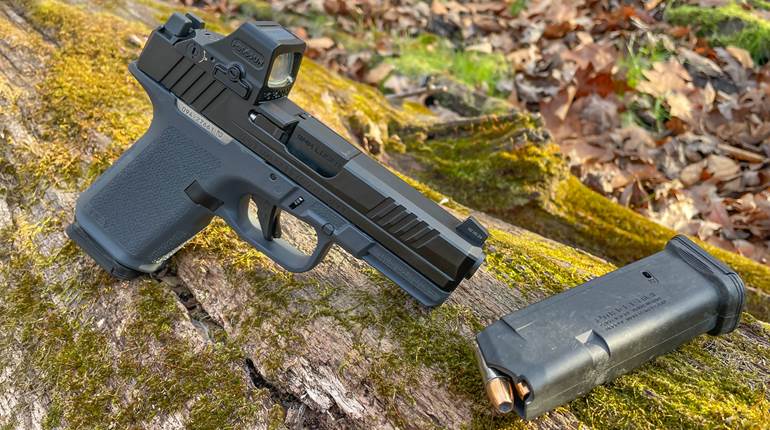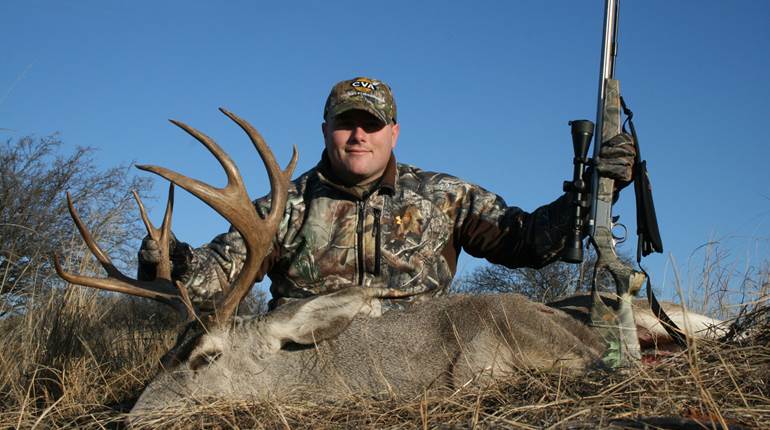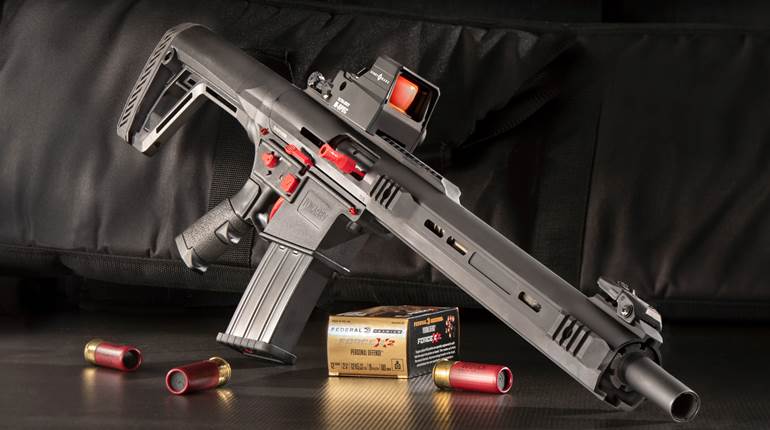
The company has, on an inconsistent basis, produced handguns, rifles and shotguns during its century-plus existence, but, in recent years, Savage has worked hard at making strides in markets outside of its established, bread-and-butter product line: rifles. The effort has paid dividends, as Savage’s American-made, semi-automatic Renegauge 12-ga. shotguns have made inroads into a very crowded and well-established field.
When the Renegauge debuted in January 2020, Savage Arms prudently clung to the common practice of first delivering shotguns in utilitarian hunting configurations. In this case, it was the Field, Waterfowl, Turkey Obsession and Turkey Bottomland versions. Smart. Why dive in before testing the waters, right? Given that the initial offerings yielded results, the company recently added the aptly named Competition and Security models, which are reviewed here. These were planned as part of the original Renegauge product plan. A third model, the Prairie, joined them but won’t be covered in this article. Before delving into the specifics of the aforementioned duo, it’s prudent to examine the commonalities within the line.

Renegauge Specifics
Semi-automatic shotguns typically use either a gas or “inertia” operating system, and there are benefits and drawbacks to each that bear mentioning here. Inertia-driven shotguns—think Benelli—require fewer parts and don’t rely on gases to operate; therefore, they are usually lighter, faster and easier to clean. Maintenance is minimal. But perceived recoil is typically greater than that generated by gas-operated shotguns, which utilize a portion of the gas produced during firing to cycle the action. The additional parts required by the operating system increase the gun’s weight, but that helps reduce felt recoil. Beyond extra weight, the primary shortcoming of gas-operated shotguns is that, along with the gas, fouling and debris also enter the operating system, so the cleaning process is lengthier and must be carried out more frequently to ensure reliable functioning. Renegauge shotguns are gas-operated.
Renegauge shotguns are equipped with Savage’s innovative Dual Regulating Inline Valve (D.R.I.V.) system. Here is how it works: When the shell is fired, gas is vented through multiple staggered barrel ports into the D.R.I.V. system, which is designed to harness the energy needed for cycling the action and immediately vent the excess gas forward through ports hidden by the fore-end, reducing recoil and wear. This allows them to cycle ammunition ranging from mild 2¾" target loads to the hardest-hitting 3" magnum loads.
Gas bled from the barrel will interact with the single large piston, which subsequently interacts with the 15.5-oz., chrome-plated-steel action-bar assembly (with integral bolt), forcing it rearward. Once the rotating bolt head unlocks, the unit will move rearward, compressing the hearty recoil spring surrounding the barrel, while extracting and ejecting the shell and, ultimately, cocking the hammer. Powered by the decompressing recoil spring, the assembly returns forward, collecting and chambering a shell from the carrier and then completing lockup. The aforementioned process is remarkably fast. A nice feature is that the bolt is designed so that it can be retracted slightly to confirm that the chamber is loaded, and it will effortlessly return to battery.
The Renegauge Competition and Security models, like their predecessors, have aluminum receivers with aesthetically pleasing lines, though the enlarged “Renegauge” on the left side of the receiver is a tad much. As for the fire controls, there’s an oversize bolt release, cartridge-release lever and crossbolt safety, which is at the rear of the trigger guard. The safety employs a reddish O-ring, which serves as a visual indicator and keeps it secure. The trigger group is held in place by a single, easily removed pin with an identical O-ring. The O-ring resides in a groove inside the left receiver wall and must be added before the pin is inserted. Five extras are provided with the shotgun. The receiver is drilled and tapped for the addition of a sight or optic. To speed loading, Savage beveled the loading port, as well as added a slight channel on the bottom of the carrier that aligns with a cutout on the front of the trigger guard. It’s the smoothest transition for a shell that I’ve encountered.

Regardless of the model, Renegauge shotguns are fitted with a thick, heavy, carbon-steel barrel with fluting along its length and a Melonite finish. The flutes are designed to reduce barrel flex, while the overall additional weight lessens perceived recoil. Renegauge barrels are threaded to accept the readily available Beretta/Benelli Mobil-pattern choke tubes. Topping the barrel of most versions is a ventilated, carbon-steel rib, although the Competition and Security models are exceptions—more on that shortly.
All Renegauges are equipped with a highly customizable, Monte Carlo-style synthetic stock. Accompanying the shotguns are two extra-pliable check pieces (combs) of varying height, as well as two additional recoil pads and shims for achieving the perfect length of pull and cast. Screws for attaching the recoil pads are also provided.
Concerning the aesthetics, the buttstock has the modern approach of sharp lines, angles and flat surfaces, which is more reminiscent of that on a rifle than a shotgun. Most unusual, or atypical, in my mind was the lengthy pistol grip. Sure, it had the usual swell and impressed texturing to improve purchase, but nearing its bottom is a groove and flaring that creates a lip for the small digit to rest. I’m not a fan, but that’s neither here nor there. The fore-end has multiple grooves and integral texturing to enhance purchase—the latter of which does a fine job.
Breaking Down The Competition
Shotgun sports come in many guises, but if you guessed that a shotgun coined the Competition would be for clays games, such as skeet, trap and sporting clays, among others, you’d be wrong; as evidenced by its features, which were suggested by several strong Team Savage shooters who compete in 3 Gun. In fact, the aesthetics alone would suggest that it’s not for typically conservative clays courses.

The combination of red and black finishes is striking. To achieve the appearance, Savage employed a matte-black finish (Melonite) on the stock, fire controls, other than the trigger, and most metal parts, while red Cerakote was used on the receiver, trigger, magazine tube extension and extended choke tube. A red follower is also a nice touch. But finishes alone aren’t enough to win competitions. In such games, speed trumps appearance.
Obviously, the more shells that reside in the shotgun (as opposed to being on the hip) when starting a run, the fewer reloads and time spent reloading will be required. Therefore, the 3", 12-ga. Competition’s extended tubular magazine holds nine shells, for a 10-round capacity. That gives the magazine tube a length just shy of the muzzle when the latter is fitted with the included, extended choke tube. Providing sufficient tension along that length requires two springs secured together with a spring coupler. Included with the shotgun are detailed instructions on how to disassemble and re-assemble the extended magazine. Finesse and patience are essential to completing the task. For those looking to decrease the magazine capacity, a plug is provided.

Securing the barrel and magazine extension is an aluminum barrel clamp with M-Lok attachment slots, which must be removed before the Competition can be disassembled. A 9/64" hex wrench is required to do so.
 Considering the intent of the Competition, it makes sense that the 24" barrel—better for distance work—is equipped with a red, Hi-Viz Tri Comp front sight. Acquisition is immediate, and the triangular design gives sighting options (i.e., whole sight, top point). This’ll prove to be most beneficial when slugs are employed.
Considering the intent of the Competition, it makes sense that the 24" barrel—better for distance work—is equipped with a red, Hi-Viz Tri Comp front sight. Acquisition is immediate, and the triangular design gives sighting options (i.e., whole sight, top point). This’ll prove to be most beneficial when slugs are employed.
Because of the varying distances and target types encountered on the 3 Gun course and other shotgun sports, Savage prudently provides a variety of high-quality, tungsten-approved Trulock chokes to accompany it. The only extended choke is a 0.710" (Skeet 2), or light modified, which is frankly all you’ll need. From smashing distant clays to buckshot and slugs, it’ll handle it all. See the nearby table for proof. Still, the company provided (in a case with a choke tube wrench) flush-fitting 0.695" and 0.715" chokes, which are full and improved cylinder constrictions, respectively.
On the sample Competition, the trigger broke at 5 lbs., 6 ozs., and exhibited some creep, with the last bit of take-up being noticeably gritty and rough. Reset distance and overtravel, though, were minimal.
Security Detail
While shotguns designed for self-defense can certainly pull double-duty for other tasks, the Renegauge Security is smartly designed for its given job. Unlike its hunting and Competition counterparts, the Security is all-business, and its aesthetics reflect that; there are no flashy colors. Instead, it’s a combination of matte black and gray. While the metalwork is primarily black (Melonite, anodized, etc.), the plastic furniture is mostly gray. The only red on the gun is the follower.

Given that the Security model is intended for defense, Savage prudently increased the magazine capacity to six rounds via a magazine tube extension. Unlike its aforementioned counterpart, the Security’s magazine tube doesn’t require a second spring and coupler, and thus it’s easier to uncouple and reunite. The extension is barely longer than the barrel, too. If a lesser capacity is desired or required, a plug is provided. An M-Lok barrel clamp secures the barrel and extension together. Again, it must be removed at the outset of the shotgun disassembly process.
In the confines of a home or camp (defense against four-legged marauders), a lengthy barrel is a hindrance. As such, Savage Arms opted for an 18½" barrel, sans rib—the only model in the line like that. Topping the Security model are ghost-ring sights. The winged rear has an enlarged “peep” and is adjustable for windage and elevation, while the winged front has a green, fiber-optic pipette for rapid acquisition. And fast it is.
Accompanying the gun are three flush-fitting Trulock choke tubes in the following constrictions: 0.695" (full); 0.705" (modified); and 0.715" (improved cylinder). For defensive use, it’s unlikely that anything but the IC will be employed, however, the others increase its versatility. A choke tube case and wrench are also supplied.
The sample Security’s trigger broke at an average pull of 5 lbs., 4 ozs. There was considerable creep, and the reset was longer than that of the Competition.

Renegauges at the Range
Testing of the Renegauge Competition and Security shotguns consisted of patterning, chronographing and extreme function testing, and it took place over a several-day period with varying conditions. For patterning, I selected loads that would likely be used for the gun’s given task. For instance, the Competition was pattern tested at 40 yards using Italian-made C.C.M. Ammo RX 4 Champions, which is made by Clever—a true premium target load. The load featured 1 oz. of No. 7½ shot propelled to 1,245 f.p.s. The Security variant was patterned at a distance of 25 yards with American-made 2¾" Remington Ultimate Defense Managed Recoil Buckshot featuring 21 pellets of No. 4 buckshot pushed to 1,200 f.p.s.
Despite being tested at 40 yards using the extended, light-modified (0.710") choke, as evidenced in the accompanying table, patterns through the Competition were quite good. This can be attributed to the barrel, choke and renowned, high-quality shot found in top-tier Clever-produced loads. With a standard deviation of 9 for 10 consecutive shots, the round-to-round consistency was superb, too. Suffice it to say, for whatever you’ll encounter on a 3 Gun course, the provided Skeet 2 choke tube should handle it with aplomb.
 Concerning sighting, when aiming (rather than pointing, which is what is done in most shotgunning) using the tip of the triangular sight, the gun patterned low and slightly right. You’ll note that in the accompanying patterning chart. A more centered aim would elevate the pattern, however, both approaches would result in a hard target hit. The sight was immediate to acquire, regardless of lighting conditions—midday sun, shade or the setting sun, it didn’t matter. And, if an optic were desired, the receiver is drilled and tapped to accept a base.
Concerning sighting, when aiming (rather than pointing, which is what is done in most shotgunning) using the tip of the triangular sight, the gun patterned low and slightly right. You’ll note that in the accompanying patterning chart. A more centered aim would elevate the pattern, however, both approaches would result in a hard target hit. The sight was immediate to acquire, regardless of lighting conditions—midday sun, shade or the setting sun, it didn’t matter. And, if an optic were desired, the receiver is drilled and tapped to accept a base.
When using the improved cylinder choke, the Security model produced consistently dense patterns at 25 yards; in fact, outside of a single pellet from one shell, none of the buckshot exited the inner circle. Obviously, the barrel design and choke played a role in the outcome, however, the wad design in the reduced-recoil Remington load is the key contributor. The short cuts to the shotcup prevent the pellets from spreading too fast. Due to the abbreviated barrel, the 1,163-f.p.s. average velocity for 10 shots was shy of the published 1,200 f.p.s. That’s to be expected. Still, it cycled flawlessly and hit hard—perfect for hunting and personal protection. From the factory, the gun patterned high, but the rear sight could be quickly and easily dialed-in.
Savage Arms heartily promotes the reliability of its Renegauge shotguns with varying loads, so I sought to test that assertion with the greatest mishmash of 2¾" and 3" 12-ga. ammunition that I have ever assembled. I succeeded. Low recoil? Got it. Slugs? Yep. Steel and tungsten waterfowl ammunition? Absolutely. Oldies but still safe? Ran ‘em. One-off reloads with cosmetically imperfect crimps? You bet. Frankly, the Renegauge shotguns became a way to get rid of new and undesirable shotshells in the name of testing. Over several days, I ran both guns nonstop for lengthy stints with the aforementioned assortment and found that, short of a few irregular handloads (Security) and one box of decades-old Fiocchi slugs (Competition), the guns cycled all non-subsonic shells flawlessly—even when they were filthy internally. There were zero malfunctions with new, factory ammunition in either gun, proving Savage’s claim. Would I trust my life or competition to these shotguns? Absolutely.
As for general observations, the 8-lb., 3-oz., Competition was quick to shoulder and, despite its weight, was easy to point and swing. However, that weight would, in time, become tiresome for any sport requiring supporting it for extended periods. For 3 Gun, which is its specialty, that’s a moot point, and the weight helps reduce perceived recoil, to boot. The gun’s 24" barrel would allow it to be used on most public ranges, though the number of rounds permitted to be loaded at a time could be as low as two.
My only complaint with the Competition was that after the extensive range sessions, I attempted to remove the promotional sticker from the fore-end for photography. Unfortunately, in doing so, it also removed some of the finish, which revealed the gray fore-end beneath. Reaching out to Savage, I was overnighted a free replacement fore-end, which had a more subdued, matte finish, and sent the faulty piece in for inspection. Despite several requests, no explanation was provided as to why the finish on the original fore-end came off.
Although I’m an NSCA Master Class 12 Gauge sporting clays shooter accustomed to using all manner of competition shotguns, frankly, I was more enamored with the 7-lb. Security model than the Competition due to its size and utilitarian nature; the Competition is designed primarily to excel in 3 Gun. I found that the Security came to the shoulder and pointed instinctively, and the sight acquisition with the ghost-ring sights was speedy, making it suitable for myriad roles. From protecting one’s abode and hunting camp, to hunting feral hogs and deer in dense cover, to following up a black bear or securing meat for camp, the Security model will handle it all—especially with the extra chokes and drilled-and-tapped receiver, which will allow for the addition of an optic. Plus, it patterned densely with buckshot at hunting distances.
With the Renegauge, Savage Arms proved that it was as capable of producing a performance-driven shotgun as it is an accurate rifle. With the Security and Competition additions, the company demonstrated that it was keen enough to diversify its portfolio with purpose-specific models that consumers need and want. 






































